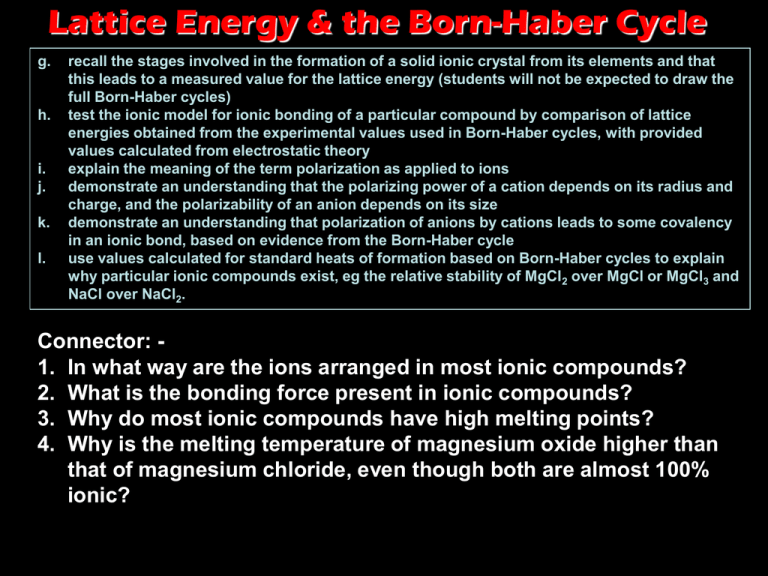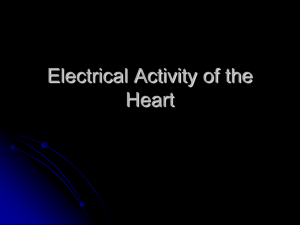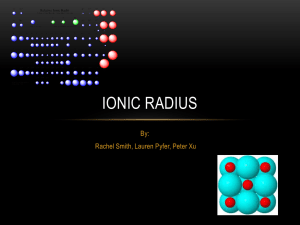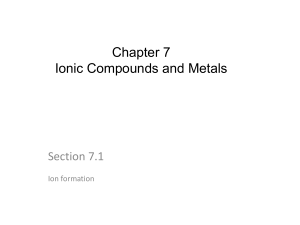File
advertisement

Lattice Energy & the Born-Haber Cycle g. h. i. j. k. l. recall the stages involved in the formation of a solid ionic crystal from its elements and that this leads to a measured value for the lattice energy (students will not be expected to draw the full Born-Haber cycles) test the ionic model for ionic bonding of a particular compound by comparison of lattice energies obtained from the experimental values used in Born-Haber cycles, with provided values calculated from electrostatic theory explain the meaning of the term polarization as applied to ions demonstrate an understanding that the polarizing power of a cation depends on its radius and charge, and the polarizability of an anion depends on its size demonstrate an understanding that polarization of anions by cations leads to some covalency in an ionic bond, based on evidence from the Born-Haber cycle use values calculated for standard heats of formation based on Born-Haber cycles to explain why particular ionic compounds exist, eg the relative stability of MgCl2 over MgCl or MgCl3 and NaCl over NaCl2. Connector: 1. In what way are the ions arranged in most ionic compounds? 2. What is the bonding force present in ionic compounds? 3. Why do most ionic compounds have high melting points? 4. Why is the melting temperature of magnesium oxide higher than that of magnesium chloride, even though both are almost 100% ionic? Connector: 1. In what way are the ions arranged in most ionic compounds? 2. What is the bonding force present in ionic compounds? 3. Why do most ionic compounds have high melting points? 4. Why is the melting temperature of magnesium oxide higher than that of magnesium chloride, even though both are almost 100% ionic? 1. Giant ionic lattice (structure) 2. Electrostatic attraction 3. High melting points because of the large number of strong ionic bonds that need to be broken. Thus a lot of energy is needed to break them all. 4. • The oxide ion has a greater (negative) charge / greater charge density than the chloride ion • So the force of attraction between ions is stronger in MgO (than MgCl2) / stronger ionic bonding in MgO (than MgCl2) • And so more energy is required to separate the ions in MgO (than MgCl2) / more energy is required to break (ionic) bonds in MgO (than MgCl2) Energy changes when ionic Lattices are formed • • • • • • • • • • Is it an endothermic or exothermic process to form gaseous ions from metallic elements in the gaseous state? Endothermic What is the name given to the energy needed to do this? Ionisation energy Is it an endothermic or exothermic process to form gaseous ions from non-metallic elements in the gaseous state? Exothermic What is the name given to the energy needed to do this? Electron affinity What about when the ions come together to form a lattice? Exothermic – energy given off is known as the lattice energy/enthalpy. Definition - Lattice energy of an ionic crystal is the enthalpy of formation of one mole of an ionic compound from gaseous ions under standard conditions. Born-Haber Cycle • A special type of enthalpy level diagram that allows you to work out lattice energies. + • Use the work sheet provided and label each step in the Born-Haber Cycle. • Then calculate the value of the lattice energy for sodium chloride. Born-Haber Cycle Standard enthalpy of: • formation of sodium chloride + • atomization of chlorine standard • atomization of sodium • first ionization energy of sodium • first electron affinity of chlorine • lattice enthalpy of sodium chloride Enthalpy of atomization of chlorineΔat Enthalpy first ionization energy ofΔ sodium ie1 Enthalpy of atomization of sodiumΔat Enthalpy of formation Δf of NaCl Enthalpy of first electron Δea affinity of chlorine Na+(g) + e- + ½Cl2(g) Lattice Energy Factors Lattice energy is affected by the size and the charge of the ions involved. As ionic size increases, lattice energy decreases. The greater the charge on an ion …. ….. the greater the lattice enthalpy Predicting Stability Enthalpies of formation and Born-Haber diagrams can be used to explain stability of compounds, and why some don’t exist, eg NaCl2 Complete the worksheet: ΔHf = + 2529.6 kJ/mol Too much energy is needed and so NaCl2 does not form. Comparing ΔHf for NaCl and NaCl2 ΔHf NaCl = -787 kJ/mol ΔHf NaCl2 = + 2529.6 kJ/mol Exothermic so likely to happen. Highly endothermic unlikely to form. Energetically stable. Energetically highly unstable. Why is there such a difference? Look at the ionisation energies for Na. Explain the big difference? Where does the second electron come from? Home learning task – calculate the heats of formation for MgClx (where x=1,2 or 3) and explain why MgCl2 is the favoured structure. Comparing Theoretical and experimentally measured Lattice Enthalpy Values Here we see values calculated using Born-Haber diagrams compared with values obtained by scientists using Coulomb’s Law Differences can be explained by Polarisation. Polarisation Ionic bonds can be polarised by the cations strongly attracting the outer shell electrons of the anion. What does the polarising power of a cation depend on? • Its charge density, which depends on the size of the ions and its charge. • Smaller the ionic radius and/or the greater the charge – the greater the charge density. • For an anion, the larger the radius, the more easily it is polarised. Comparing Theoretical and experimentally measured Lattice Enthalpy Values Looking at the value for the silver halides; theoretical value is less negative. Suggests compounds are more stable than what a purely ionic model like Coulomb’s Law would indicate. Difference could be attributed to some covalent character in bond. Bond Character • When difference in electronegativity of the ions in a crystal lattice is high, the ionic model works well. • When difference in electronegativity is low, the bonding in the crystal has got high covalent character. • Why is it like this? – Well theoretical model assumes all ions are spherical and separate giving evenly distributed electron charge across the ion. – Polarising the bond, and distorting the ion, and increased covalent character; decreases lattice energy values. Questions Questions









